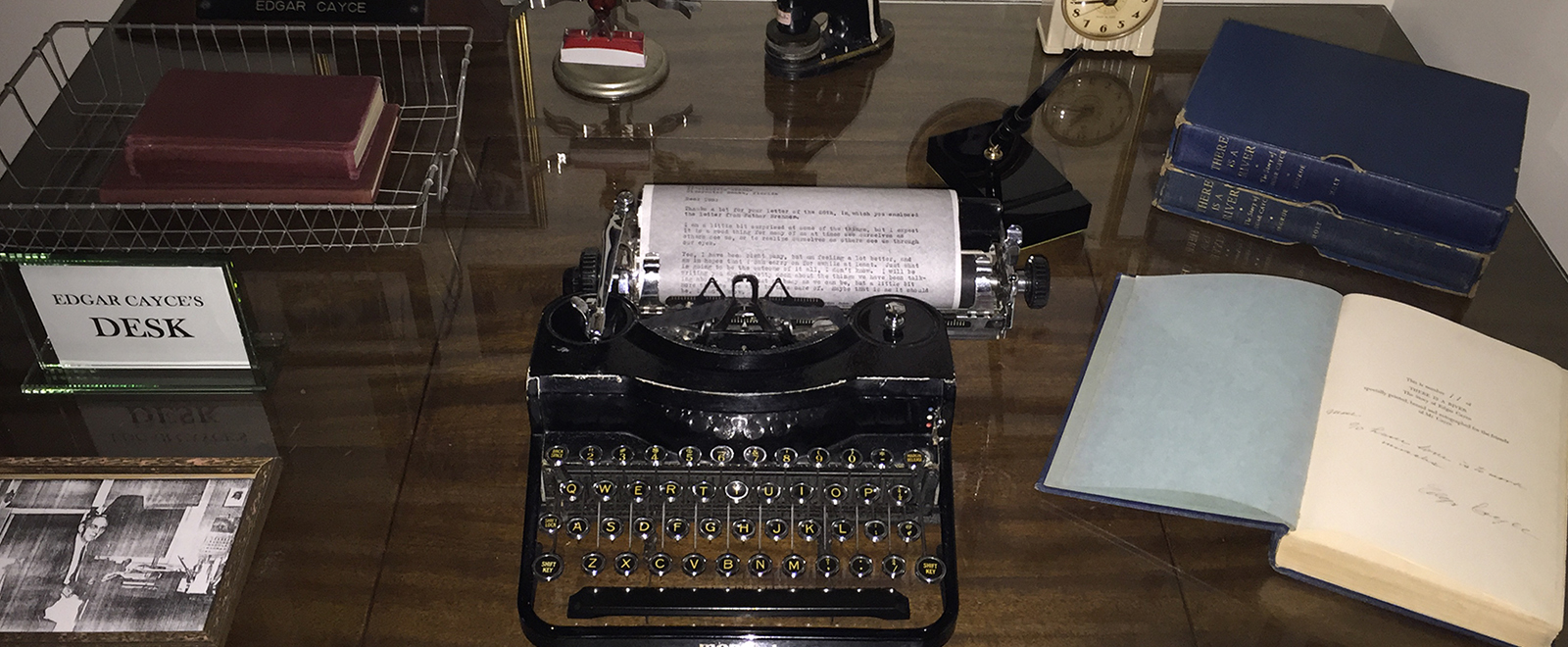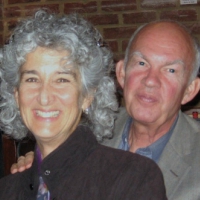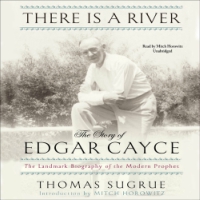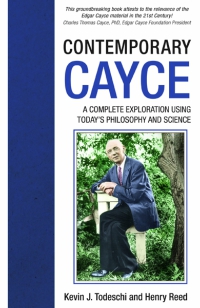It is hard for us today to grasp the enormous challenges faced by the Cayce family throughout their lives much less after Edgar Cayce died in 1945. This unique material—the information itself and the corresponding papers—could have easily died with Edgar Cayce if nothing was done. Can we even fathom what it was like facing the chaos of 14,000+ readings that were not indexed, realizing that the vital information within them was virtually inaccessible?
In 1948, the Edgar Cayce Foundation (the E.C.F.) was chartered to address just this as the legal owner and custodian of the Cayce material. The shorthand purpose of the E.C.F. is that it preserves: the original readings, supplementary letters, newspaper articles, photos—anything that proves that the readings and people's experiences with them really existed—and it preserves the integrity of the material. If it is misrepresented or blatantly exaggerated, it falls to the E.C.F., as owner and custodian of the readings, to address such breaches because without the physical “proof” and the accuracy of content, the Edgar Cayce readings become just another story and not a reality.
Gladys Davis Turner
The E.C.F.'s full charge—to protect, preserve, index, and develop guidelines to make the readings readily accessible for study and research—originally fell to Gladys Davis Turner, Edgar Cayce's secretary for over 20 years. Gladys tended to the records while Hugh Lynn Cayce, Edgar's eldest son, built the A.R.E. organization and spread the word about the readings. The life-long passion of Gladys and Hugh Lynn for this Work kept the heartbeat of the Edgar Cayce readings alive.
Let's remember who Gladys was: She started her work—indeed, she became a virtual family member—with the Cayce family when she was just 19 years old. During her 40+ years with the E.C.F., Gladys, with a steel-trap memory, recorded everything. She not only recorded almost all of the 14,000+ readings given from 1923-1945, but she also recorded tiny details: about people, their surroundings, their correspondence, even their meals! She held the organizational memory. From 1948, until her death in 1986, the A.R.E. and the E.C.F. benefited from her unfailing guidance. The E.C.F. was ill-prepared for a future without her. Gladys was the moral compass, the standard bearer. She knew and applied the readings—in her work and in her personal life. A people-person, Gladys welcomed and nurtured all with an enveloping, easy, natural warmth. I know because I was one of them.
At the time of its founding, it was understandable that at first the way forward for the E.C.F. was not at all clear. Its first professional archival assessment in 1959 shone light on two critical steps that took Gladys, with mostly volunteer help, eleven painstaking years to complete: 1) They created an indexing system uniquely tailored to the readings, and 2) They replaced all of the names within the readings with numbers so that a duplicate set could provide public access to them while protecting the privacy of readings’ recipients (approximately 5,750 people). Thanks to this Herculean effort, in 1970, twenty-five years after Edgar's death, the complete Edgar Cayce readings became available to the public for the first time.
Yet Gladys was not a business person, nor a bureaucrat. She left behind few written policies and guidelines. Her specific though unofficial procedures were passed on informally, as needed, often within memos. There is only so much one central person can do and so it was that the pressing needs to properly preserve and house the archival materials fell to the wayside, as did formalizing guidelines for their proper access.
Even into the early 1980s, the importance of the role of the E.C.F was not well understood by the organization at large. Just five years before she died, Gladys had to justify and virtually plead for more help and attention for the E.C.F. So it is no surprise that after her death, the E.C.F. suffered. Though urgently needed, the real work of properly preserving, indexing, and disseminating the archival information stalled, as the E.C.F. was now staffed with untrained, part-time volunteers and/or A.R.E. staff. The Foundation fell dormant—regrettably, for most of the next 30 years. This is why many of us today know little about it. Like a buried treasure, it's been waiting to be discovered again.
Today
In 2017, thanks to the support of members who are passionate about the E.C.F. and preserving these records, a new day dawned with the E.C.F.'s second major archival assessment. Like its predecessor, this report laid out a clear blueprint that led to a burst of long overdue activity. In the spring of 2018, a major step forward in this process was the hiring of a full-time archivist, Jessica Newell, M.A.L.S. [Read our news release about her hire for more details.] Her energy, focus and expertise have been instrumental in infusing the E.C.F with new life. Under Jessica’s direction, in just six months, the E.C.F. has:
- Acquired an online database and exhibition tool for online access to our collections;
- Installed a fire suppression system;
- Installed an air conditioning system so the archival standard preservation temperature of 64 degrees is now maintained in the vault;
- Acquired preservation tools, archival boxes, etc., for safely rehousing our collections;
- Acquired a high-quality scanner for proper digitization of all records;
- Updated the organizational system for all materials;
- Created an emergency response plan for the vault;
- Begun an audio-visual inventory for grant proposals;
- Made significant progress on rehousing the original readings as well as cataloging and rehousing 18 other collections;
- Worked with designers so that a new E.C.F. website will soon showcase the contents of the E.C.F..
While there's much more yet to be achieved, there is now organizational commitment to a permanent, professional archival position to ensure the E.C.F.'s vital needs and standards are maintained.
It's About the Readings
The supplementary materials to the readings form a rich treasure trove of untapped documentation that enriches and enlivens them. The Cayce readings, while entwined with universal truths, were given for one individual at a time; they are highly personal. The physical, mental, and spiritual issues addressed, with wisdom and miraculous accuracy, are for one person. Ultimately a Cayce reading gives that individual a glimpse into their soul's development—it doesn't get more intimate, or more important.
From its inception, the E.C.F. has taken its mission of safeguarding the material, and the individuals behind it, seriously. Gladys set the bar, maintaining clear confidentiality standards per the readings' counsel. The E.C.F. is to serve as the link between an inquiring public and the readings' recipients.
Here's how Gladys did this: An author like Gina Cerminara, while researching her bestselling book, Many Mansions, or Jess Stearn, while researching his bestselling book, The Sleeping Prophet, submitted to the E.C.F. the nature of their project and their requests to interview readings' recipients. Gladys facilitated the contacts between them and the recipients, assisting both as needed. In turn, the authors agreed to share with the E.C.F., per its charter, any supplemental information from the interviews that shed light (positive or negative) on a reading. In this way, the readings were updated, living documents.
Sadly, like the need for preservation, this established pattern of communication and cooperation between researchers and the Foundation has faltered since Gladys died, although it is a hallmark of the E.C.F.'s mandate. Yet today, policies and procedures, based on archival standards and historical precedents like these, put an end to this neglect.
These guidelines ground the Foundation’s proper function. The upcoming E.C.F. website will open an ever-expanding view into what's in the archives and its function “in decency and order.” The E.C.F.'s overarching goal—to make available its archival materials while preserving their physical integrity and the integrity of the information itself—is finally coming to fruition.
The Future
The E.C.F. is poised to enter the 21st archival century. This will include reviving the original indexing system precisely tailored to the Cayce readings, per the first archival assessment. This indexing system provides targeted access into the material, facilitating research. Over 70 percent of the readings are physical. Recall their uncanny accuracy. They are rich with hypotheses and with healing potential. As new doors open into the Cayce readings, new avenues of study will reach an ever-expanding audience.
A simple example highlights this potential to verify Edgar Cayce's readings and, in this instance, his psychic ability in new ways. Recent correspondence with a living recipient about her life reading, given when she was a child, revealed that a tiny physical detail at the end of it—in which Cayce said, “Beware of the lung”—proved to be true. (A physical comment like this tucked into a life reading, or spiritual guidance within a physical reading, is typical. It is emblematic of the wholistic thread that runs so clearly through this body of work. Mental, physical, and spiritual guidance bound together makes up the whole.) This recipient, near the end of her life, had indeed been diagnosed with and subsequently died of lung cancer.
Imagine a research study of corroborating information like this. It could potentially verify the extent of Edgar Cayce's abilities in a new and different way. Just like a potential Edgar Cayce movie, such research brings us an expanded audience facing life’s most relevant questions:
Who are we, really? Are we more than our physical bodies? And the implications of that are unlimited.
The future fast approaches and with its revitalization, the E.C.F. is ready.








